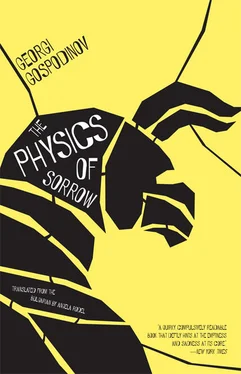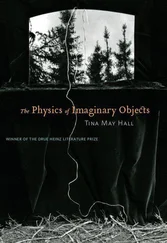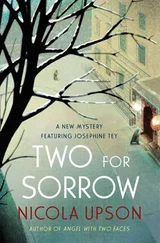You stand amid all that chaos, mooning about, you don’t know where to turn, the adults don’t either, they’re stressed out, waiting for the truck and smoking. Then everything is loaded up, but all of you are still fussing around, you don’t want to shut the door, your mother goes to check for the twentieth time to make sure you haven’t accidentally forgotten anything, your father has wandered off somewhere in the yard to water the two cherry trees and the rose bush, because who knows whether the new tenant will take care of them at all. I hug one of the cats, the other is hiding somewhere.
Farewell.
A new apartment.
New farewells.
The moves of my student years.
Moving out after divorce.
Moving to other countries.
Coming back.
A new apartment.
A whole life can be told as a catalogue of moves.
THE MOTHER CAPSULE
After that exhibit, I go back home to my boxes and bags.
At every moment (including this one), somebody is burying a time capsule somewhere. The trend peaked in 1999. Then there was a certain drop in interest. The apocalypse of 2000 didn’t come about. People were disappointed, which is understandable after all that waiting. In the meantime, Facebook cropped up, a new time capsule. Now you’re a half-human/half-avatar, a strange sort of Minotaur, no a Min-avatar. I got distracted there, that’s what Facebook does, it distracts.
What I wanted to say was that of the tens of thousands of capsules being buried in the ground annually, over ninety percent will be lost forever. The people who have buried them forget, die, move. A mother-capsule needs to be created, which would contain the coordinates of all the capsules buried around the world. And so that its coordinates wouldn’t be forgotten, a special person needs to be hired whose only job is just that — to remember them.
BUNDLE AND BOTTLE
The unlikeliest things can turn out to be time capsules. The largest is surely the city of Pompeii, which was preserved under ash. I prefer the smaller ones, myself. Like the bottle of brandy my grandfather set aside the day I was born. That bottle must be forty-four years old now. If I find it and open it, I’ll have distilled the whole of 1968, at least for southeastern Bulgaria. The number of sunny days that summer, the early autumn rains, the humidity in the air, the quality of the soil, the vine diseases, the year’s whole history written inside a glass bottle.
Or that bundle of clothes my grandma kept for “the end.” A kerchief, an apron, a cherry-red vest, wool socks for winter, or pantyhose — in case it’s summer — a pair of patent-leather shoes. A bundle to be opened on the day of her death. Even though she would open it every other day, to make sure moths hadn’t chewed holes in the clothes or simply to look at them. That’s a way of getting used to the idea of death, too. Once a month, she would put them on. She would replace her old black kerchief with the new one with its big, dark-red roses, her everyday brown woolen vest with the unworn red one, which had been given to her for some birthday. She would look at herself in the narrow rectangular mirror, bemoaning how pretty she had been back in the day, what a slender waist she had had. How can I show up there like this, she would cry. Only death awakened her vanity. More people were waiting for her there than here.
. AND HEXAMETER
The unlikeliest things can turn out to be. Hexameter, for example. If something is said in hexameter, then historically and practically speaking, it has an infinite expiration date. The whole of the Trojan War is preserved in the capsule of hexameter. If that story had been stuffed into any other form whatsoever, it would have given out, gone sour, gotten torn up, crumbled. Hexameter turned out to be the longest-lasting material.
Hesiod, in his Works and Days , has left behind a true survival kit with instructions. If something happens to the world and people come who don’t know anything, thanks to this book they will learn which month is good for sowing, which for plowing, when a boar or a bellowing bullock or a hardworking donkey should be castrated.
It also includes these favorite instructions:
One should not urinate facing the sun while standing erect, but
One should remember always to do it at sunset and sunrise.
Nor should you piss on the path or next to the path when out walking;
Nor should you do it when naked; nighttime belongs to the blessed.
For everything, there should be a good book giving instructions. I add it to the box, too.
BEES AND BATS
At the end of every year I open up the boxes, carefully look through all the publications from January to December, sometimes that is precisely what fills up my days until New Year’s Eve, and I set aside only the most important things that need to be preserved.
I have my own system for sorting.
Often, the most important bits of news turn up on the pages of thin, irregular periodicals printed on cheap paper, such as Modern Beekeeper, Gardening Time, Houseplant Diseases, Taking Care of a Small Farm, Bull and Cow: Newspaper for the Novice Farmer, Home Veterinarian, All About Cats , and so on.
Sometimes those five lines from the “Strange News from around the World” column can turn out to be important, especially when they’re describing the strange behavior of several colonies of bees in some remote North American town. The bees flew out of the hives in the morning and never came back. Now that’s what I call a sign and a revelation, even though nobody noticed it at the time. People don’t make the effort to read signs. They chalked up the bees’ mysterious disappearance to the Varroa destructor, the Varroa mite to be precise, also called the “vampire worm,” a tiny red tick that sinks its little hooks into the bee’s body. I wrote a letter to the newspaper, explaining that this was something else entirely, that this was only the beginning, I even quoted Einstein, people are impressed when they hear Einstein: “If the bee disappeared off the surface of the globe, then man would only have four years of life left.”
They weren’t impressed.
It seems to me that the year was 2004, the winter of 2004, yes. A whole two years had to pass before people figured out that this wasn’t some one-off case and that something strange was happening to all the bees around the world. Only in 2006 would those few lines from my beekeeping newspaper become front-page headlines in the New York Times , the Guardian and so on. And only then would they dub this strange disappearance of the most responsible and disciplined part of our holy family here on earth “Colony Collapse Disorder” (CCD). Hives are being deserted. One of the most domestic of creatures has lost its ability to find its way home, it gets lost and dies. Remember that diagnosis. Colony Collapse Disorder. The disintegration of the apian family. If this is happening to them, what is left for man and his unstable family? There’s more apocalypse in that than in all the other hocus-pocus. The bees are the first sign. The buzzing angels of the apocalypse. We’re expecting the trumpets of Jericho, but the only thing that can be heard is bzzzz. bzzzz. bzzzz. growing quieter and fading away. That’s the signal. Don’t you hear it? Just take out your iPod earbuds for a minute.
And what do we know about White Nose Syndrome? White Nose Syndrome in bats. We haven’t even heard? No one counts dead bats. Look, if they were pigs or cows, everybody’d be worried. In 2006, ninety percent of the bat population in the caves around New York and San Francisco suddenly and somewhat inexplicably died. They stopped eating and hung comatose before finally flying out of the caves and falling to the ground outside with white noses. Small flying mice with white noses, miniature dead Batmans. I add this information to the box as well, it may turn out to be important.
Читать дальше












